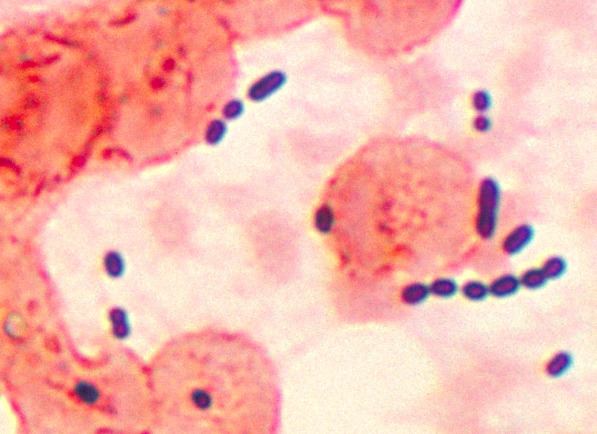Higher classification Enterococcaceae Order Lactobacillales | Division Firmicutes Scientific name Enterococcus Rank Genus | |
 | ||
Lower classifications Enterococcus faecalis, Enterococcus gallinarum, Enterococcus avium | ||
Enterococcus
Enterococcus is a large genus of lactic acid bacteria of the phylum Firmicutes. Enterococci are Gram-positive cocci that often occur in pairs (diplococci) or short chains, and are difficult to distinguish from streptococci on physical characteristics alone. Two species are common commensal organisms in the intestines of humans: E. faecalis (90–95%) and E. faecium (5–10%). Rare clusters of infections occur with other species, including E. casseliflavus, E. gallinarum, and E. raffinosus.
Contents
Enterococcus
Physiology and classification
Enterococci are facultative anaerobic organisms, i.e., they are capable of cellular respiration in both oxygen-rich and oxygen-poor environments. Though they are not capable of forming spores, enterococci are tolerant of a wide range of environmental conditions: extreme temperature (10–45 °C), pH (4.5–10.0), and high sodium chloride concentrations.
Enterococci typically exhibit gamma-hemolysis on sheep's blood agar.
History
Members of the genus Enterococcus (from Greek έντερο, éntero, "intestine" and κοκκος, coccos, "granule") were classified as group D Streptococcus until 1984, when genomic DNA analysis indicated a separate genus classification would be appropriate.
Pathology
Important clinical infections caused by Enterococcus include urinary tract infections, bacteremia, bacterial endocarditis, diverticulitis, and meningitis. Sensitive strains of these bacteria can be treated with ampicillin, penicillin and vancomycin. Urinary tract infections can be treated specifically with nitrofurantoin, even in cases of vancomycin resistance.
From a medical standpoint, an important feature of this genus is the high level of intrinsic antibiotic resistance. Some enterococci are intrinsically resistant to β-lactam-based antibiotics (penicillins, cephalosporins, carbapenems), as well as many aminoglycosides. In the last two decades, particularly virulent strains of Enterococcus that are resistant to vancomycin (vancomycin-resistant Enterococcus, or VRE) have emerged in nosocomial infections of hospitalized patients, especially in the US. Other developed countries, such as the UK, have been spared this epidemic, and, in 2005, Singapore managed to halt an epidemic of VRE. VRE may be treated with quinupristin/dalfopristin (Synercid) with response rates around 70%. Tigecycline has also been shown to have antienterococcal activity, as has rifampicin.
Enterococcal meningitis is a rare complication of neurosurgery. It often requires treatment with intravenous or intrathecal vancomycin, yet it is debatable as to whether its use has any impact on outcome: the removal of any neurological devices is a crucial part of the management of these infections. New epidemiological evidence has shown that enterococci are major infectious agent in chronic bacterial prostatitis. Enterococci are able to form biofilm in the prostate gland, making their eradication difficult.
Water quality
In bodies of water, the acceptable level of contamination is very low; for example in the state of Hawaii, and most of the United States, the limit for water off its beaches is a five-week geometric mean of 35 colony-forming units per 100 ml of water, above which the state may post warnings to stay out of the ocean. In 2004, Enterococci sp. took the place of fecal coliforms as the new USA federal standard for water quality at public saltwater beaches and E. coli at freshwater beaches. It is believed to provide a higher correlation than fecal coliform with many of the human pathogens often found in city sewage.
